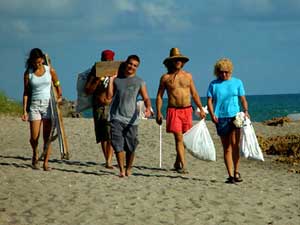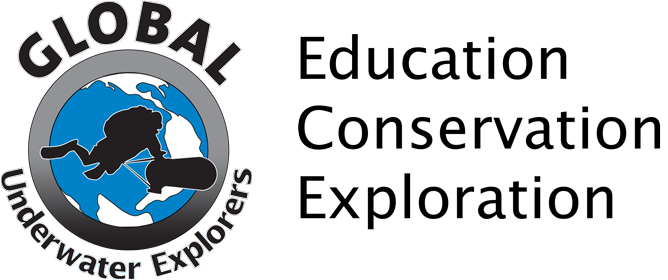Beach clean-up 2003
Beach clean-up 2003
By Corey Jablonski
The GUE beach cleanup, held on September 21, was part of the Ocean Conservancy’s International Coastal CleanupTM (ICC). While people in Singapore were collecting trash from their coastlines, GUE volunteers were scouring the beach of Hutchinson Island located in Martin County, Florida. Although the beach cleanup was held Saturday from 8-12, the coordinator of the event, Sarah Cervone, took advantage of the presence of GUE members to plan a whole weekend of activities, starting Friday night with dinner. After the cleanup on Saturday, volunteers visited Gilbert’s Bar House of Refuge, the oldest building on the Treasure Coast and the only fully restored House of Refuge in Florida. Following that, everyone gathered at Bathtub Reef Beach for a picnic. Later in the evening, George Irvine, Director of WKPP spoke about the DIR philosophy. Sunday morning a fish identification class was taught by Matthew Hoelscher, a GUE member, and then GUE instructor, Dave Sweetin, spoke about positive diver impact.
According to the Ocean Conservancy, the ICC, now in its 17th year, is the "oldest and largest beach and waterway cleanup with data collection in the world. Volunteers from around the globe and 55 U.S. states and territories participate each year, clearing tons of trash from coastlines, rivers and lakes. Ultimately, the goal of the ICC is to eliminate the need for cleanups by preventing people and industries from polluting our waters in the first place." 1 Specifically, Martin County, with the help of "more than 1,000 volunteers, removes an average 13 tons of litter and marine debris from the county's beaches, rivers and waterways." 2
| Click to play video |
So, it is not a surprise to me that I didn’t know where Hutchinson Island was. It took going to college in a city with the closest ocean more than two hours away, for me to realize a true appreciation of that particular natural resource, which lead to a greater concern over the impact of pollution on all of our natural resources.
However, I have never considered myself an avid environmentalist and I probably never will. I do what I can; I recycle, I try not to use Styrofoam, I refuse to allow the grocery stores to put two items in a bag, and most importantly, I think, I am aware of the consequences of our actions. However, I am a consumer, as we are all, and all consumers at some point do something that is environmentally unfriendly. Does that make us bad people? No. I’d like to think most people who disregard the global implications of things like litter and pollution are under the impression that one person can’t make a difference. I have to admit, I was once similarly pessimistic about the impact one person can have. Occasionally, I even have to remind myself that pessimistic individuals add up to a pessimistic majority, which does absolutely nothing for our environment.
 |
The shoes, toothbrushes, knives, plastic silverware and diapers, which are easily identifiable, are environmentally damaging enough. Monofilament line in small quantities is nearly invisible, but with a focused collection of it, you realize just how many people are either unaware of the dangers monofilament can cause, or just don’t care. According to the Monofilament Recovery and Recycling Program (MRRP) of Brevard County, "monofilament fishing line entangles wildlife, is eaten by and poisons animals from birds and fish, to manatees and turtles, and is a possible hazard to boaters... entangling propellers and blocking intake valves." 3 The problem is compounded by the fact that "monofilament line lasts up to 600 years in the outdoors." 3
 |
GUE’s purpose is education, research and exploration. All three seem pretty self-explanatory, but how exactly do you educate someone NOT to litter and to take care of our environment and our natural resources and to be socially conscious? It’s not that I don’t believe it can’t be done, rather, it should never have to be. Education is most effective through example, and I suspect that the only real way to help others understand is by maintaining our current position: preservation of our natural resources. Because we are an organization that deals primarily with underwater exploration, it seems to me that it would be a natural instinct for us to protect the resources that are aquatic.
GUE received coverage in the Florida Scuba News, Stuart News, High Springs Herald, and the Palm Beach Post.
1 http://coastalcleanup.org/index.cfm
2 http://www.keepmartinbeautiful.com/
3 http://www.castlow.com/mrrppr.html

